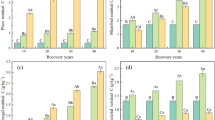Abstract
Addition of soluble organic substrates to soil has been shown to either increase or restrict the rate of microbial CO2–C evolution. This has been attributed to a priming effect resulting from accelerated or decreased turnover of the soil organic matter including the soil microflora. We investigated microbial responses to small glucose-C additions (10–50 μg C g1 soil) in arable soils either amended or not with cellulose. An immediate CO2–C release between 0 and 69 h (equivalent to 59% of glucose-C applied) was measured. However, only half of the CO2–C respired could be attributed to the utilisation of glucose-C substrate, based on the percentage of 14C–CO2 evolved after the addition of a 14C-labelled glucose tracer. Thus, although no evidence of an immediate release of ‘extra’ C above the rate applied as glucose-C was observed, the pattern of decomposition for 14C-glucose suggested utilisation of an alternate C source. Based on this, a positive priming effect (1.5 to 4.3 times the amount CO2–C evolved that was attributed to glucose-C decomposition) was observed for at least 170 h in non-cellulose-amended soil and 612 h in cellulose-amended soil. Two further phases of microbial activity in cellulose-amended soils were attributed to either activation of different microbial populations or end-product inhibition of cellulase activity after glucose addition. During these subsequent phases, a negative priming effect of between 0.1 and 1.5 times was observed. Findings indicate that the response of the microbial community to small additions of soluble organic C substrate is not consistent and support the premise that microbial response varies in a yet to be predicted manner between soil type and ecosystems. We hypothesise that this is due to differences in the microbial community structure activated by the addition of organic C and the timing of soluble organic substrate addition with respect to the current dissolved organic C status of the soil.



Similar content being viewed by others
References
Bremer E, van Kessel C (1990) Extractability of microbial 14C and 15N following addition of variable rates of labelled glucose and (NH4)2SO4 to soil. Soil Biol Biochem 22:707–713
Bremer E, Kuikman P (1994) Microbial utilization of 14C-[U]glucose in soil is affected by the amount and timing of glucose additions. Soil Biol Biochem 26:511–517
Brookes PC, Tate KR, Jenkinson DS (1983) The adenylate energy charge of the soil microbial biomass. Soil Biol Biochem 15:9–16
Button DK (1991) Biochemical basis for whole-cell uptake: specific affinity, oligotrophic capacity, and the meaning of the Michaelis constant. App Env Micro 57:2033–2038
Dalenberg JW, Jager G (1989) Priming effect of some organic additions to 14C-labelled soil. Soil Biol Biochem 21:443–448
Darrah PR (1991) Measuring the diffusion coefficients of rhizosphere exudates in soils. II. The diffusion of non-sorbing compounds. J Soil Sci 42:413–420
De Nobili M, Contin M, Mondini C, Brookes PC (2001) Soil microbial biomass is triggered into activity by trace amounts of substrate. Soil Biol Biochem 33:1163–1170
Hamer U, Marschner B (2002) Priming effects of sugars, amino acids, organic acids, and catechol on the mineralization of lignin and peat. J Plant Nutr Soil Sci 165:261–268
Joergensen RG, Brookes PC, Jenkinson DS (1990) Survival of the soil microbial biomass at elevated temperatures. Soil Biol Biochem 22:1129–1136
Jones DL, Edwards AC (1998) Influence of sorption on the biological utilization of two simple carbon substrates. Soil Biol Biochem 30:1895–1902
Jones DL, Murphy DV (2007) Microbial response time to sugar and amino acid additions to soil. Soil Biol Biochem 39:2178–2182
Jones DL, Hodge A, Kuzyakov Y (2004) Plant and mycorrhizal regulation of rhizodeposition. The New Phytologist 163:459–480
Mondini C, Cayuela ML, Sanchez-Monedero MA, Roig A, Brookes PC (2006) Soil microbial biomass activation by trace amounts of readily available substrate. Biol Fertil Soils 42:542–549
Morita RY (1988) Bioavailability of energy and its relationship to growth and starvation survival in nature. Can J Microbiol 34:436–441
Nguyen C, Guckert A (2001) Short-term utilization of 14C-[U]glucose by soil microorganisms in relation to carbon availability. Soil Biol Biochem 33:53–60
Paul EA, Clark FE (1989) Soil microbiology & biochemistry. Academic, San Diego, CA
Shen J, Bartha R (1996) Priming effect of substrate addition in soil-based biodegradation tests. Appl Environ Microbiol 62:1428–1430
Swift MJ, Heal OW, Anderson JM (1979) Decomposition in terrestrial ecosystems. University of California Press, Berkeley
Van Veen JA, Ladd JN, Amato M (1985) Turnover of carbon and nitrogen through the microbial biomass in a sandy loam and a clay soil incubated with [14C (U)] glucose and [15N] (NH4)2SO4 under different moisture regimes. Soil Biol Biochem 17:747–756
Wu J, Joergensen RG, Pommerening B, Chaussod R, Brookes PC (1990) Measurement of soil microbial biomass C by fumigation–extraction—an automated procedure. Soil Biol Biochem 22:1167–1169
Wu J, Brookes PC, Jenkinson DS (1993) Formation and destruction of microbial biomass during the decomposition of glucose and ryegrass in soil. Soil Biol Biochem 25:1435–1441
Acknowledgement
This work was funded by the Grains Research and Development Corporation (Soil Biology Initiative), with grant support from the Department of Agriculture and Food Western Australia and the University of Western Australia. Radioisotope work was conducted using facilities provided by CSIRO (Western Australia), with support from Jan Briegel and Ian Fillery. Rothamsted Research receives grant-aided support from the Biotechnology and Biological Scientific Research Council. We thank Maria De Nobili and Marco Conti (University of Udine, Italy) and David Powlson (Rothamsted Research, UK) for useful discussions.
Author information
Authors and Affiliations
Corresponding author
Rights and permissions
About this article
Cite this article
Hoyle, F.C., Murphy, D.V. & Brookes, P.C. Microbial response to the addition of glucose in low-fertility soils. Biol Fertil Soils 44, 571–579 (2008). https://doi.org/10.1007/s00374-007-0237-3
Received:
Revised:
Accepted:
Published:
Issue Date:
DOI: https://doi.org/10.1007/s00374-007-0237-3




